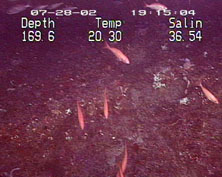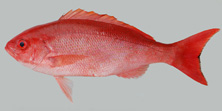Vermilion Snapper (Rhomboplites aurorubens)
- Population levels of vermilion snapper are healthy in the Gulf of Mexico. They are lower in the Caribbean and unknown in the South Atlantic. Overfishing is occurring in the South Atlantic and Caribbean.
- An amendment is currently being developed to end overfishing of vermilion snapper in the South Atlantic.
- Snapper is low in saturated fat and sodium and is a very good source of protein. For more on nutrition, see Nutrition Facts. (USDA)
- Vermilion snapper is the most frequently caught snapper along the southeastern United States, but they are not quite as popular to eat as their cousin, red snapper.
|
 |
 |
 |
 |
| Nutrition Facts |
| Servings 1 |
| Serving Weight
100g |
 |
| Amount Per Serving |
 |
| Calories 100 |
 |
| Total Fat |
1.34 g |
 |
| Total Saturated Fatty Acids |
0.285 g |
 |
| Carbohydrate |
0 g |
| Sugars |
0 g |
| Total Dietary
Fiber |
0 g |
 |
| Cholesterol |
37 mg |
 |
| Selenium |
38.2 mcg |
 |
| Sodium |
64 mg |
 |
| Protein |
20.51 g |
 |
|
 |
 Packing vermilion snapper on ice aboard the commercial fishing vessel, Nan Baldwin. Packing vermilion snapper on ice aboard the commercial fishing vessel, Nan Baldwin.
|
 |
Did you know?
Vermilion snapper is the most frequently caught snapper along the southeastern United States.
Management of the snapper grouper fishery is challenging due to a lack of data on both the resource and the fishery. Improved data collection during the 1980s and 1990s has provided more management information on some of the more commercially and recreationally valuable species, but lack of basic management data on many of the species still remains the major obstacle to successful management.
In the Gulf of Mexico, the largest quantities of vermilion snapper have been landed by Florida, followed by Louisiana.
|
|
| |
 |
|
Schools of vermilion snapper are common on reefs off the southeastern United States.
|
 |
|
Vermilion snapper have streamlined bodies which are pale to silver white below and vermilion (orange-red) above. They have narrow, yellow-gold streaks (some horizontal and others oblique) below the lateral line. The dorsal fin is rosy colored with a yellow edge. The caudal fin is red with a faint black edge.
|
|
Sustainability Status
Biomass: Gulf of Mexico biomass is 52% above the biomass needed to support maximum sustainable yield (BMSY). Caribbean biomass is 75% of BMSY*. Biomass estimates are currently unknown in the South Atlantic.
Overfishing: Yes (South Atlantic, Caribbean); No (Gulf of Mexico)
Overfished: Unknown (South Atlantic)**; No (Gulf of Mexico, Caribbean)
Fishing and habitat: Vermilion snapper are primarily harvested with hook and line gear. Little scientific information exists on the physical impacts on marine habitats from hook and line gear, but they appear to be minimal.
Bycatch: Red grouper, scamp, blueline tilefish, red snapper, gray triggerfish, greater amberjack, and white grunt are caught as bycatch in the commercial fishery for vermilion snapper. In the Gulf, vessels are required to use dehooking devices, venting tools, and circle hooks to reduce the mortality of released bycatch. The South Atlantic Fishery Management Council is currently developing requirements for dehooking devices and venting tools to reduce the mortality of released bycatch in the South Atlantic.
Aquaculture: There is currently no commercial aquaculture of vermilion snapper in the United States.
*This is the BMSY for silk snapper, which is the indicator species for the status of species in Snapper Unit 1, including vermilion snapper.
**There was a high degree of uncertainty regarding the status of vermilion snapper in the 2007 stock assessment update; therefore, scientists recommended that the species' overfished status be "unknown".
|
Science and Management
In the South Atlantic, vermilion snapper is managed as part of the Fishery Management Plan (FMP) for the Snapper Grouper Fishery of the South Atlantic region. Regulations currently include a minimum size limit of 12 inches total length, gear restrictions, an annual commercial quota of 1.1 million pounds gutted weight, and a recreational bag limit of 10 per person. In 1998, the South Atlantic Fishery Management Council established the "2 for 1" program to limit effort to address overcapitalization in the fishery. Anyone wishing to enter the commercial fishery must buy two transferable vessel permits in order to qualify for a newly issued permit, thus eliminating one permit each time a new person enters the fishery. This management measure has been effective in reducing participation in the fishery and pressure on the resource. This program will continue until the number of permits has been reduced to an optimum level to be determined based on the long-term yield of the fishery.
In the federal waters of the Gulf of Mexico, vermilion snapper is one of 42 species managed through the Reef Fish FMP. Management measures include a total allowable catch, a minimum size limit of 10 inches total length for vermilion snapper, and a 20-fish reef fish aggregate recreational bag limit.
Vermilion snapper is also included in the FMP for the Shallow Water Reef Fish Fishery of Puerto Rico and the U.S. Virgin Islands as part of Snapper Unit 1, along with silk, black, and blackfin snapper. Management measures include gear restrictions and seasonal closures.
|
Life History and Habitat
Life history, including information on the habitat, growth, feeding, and reproduction of a species, is important because it affects how a fishery is managed. Snapper grouper management is difficult because many of these species are slow growing, late maturing, and long lived, so rebuilding efforts for some species will take years to produce full recovery.
- Geographic range: In tropical waters of the western Atlantic from Cape Hatteras, North Carolina to southeastern Brazil, including Bermuda, the West Indies, and the Gulf of Mexico.
- Habitat: Vermilion snapper inhabit depths of 59 to 400 feet but are most abundant at depths less than 180 feet. In the South Atlantic, vermilion snapper are found over live bottom habitat, rock rubble, and outcroppings. In the Gulf of Mexico, they are generally associated with low profile, hard bottom habitat. Young-of-the-year vermilion snapper tend to school above reefs.
- Life span: Up to about 26 years.
- Food: Vermilion snapper feed on small animals found high in the water column.
- Growth rate: Vermilion snapper are generally considered slow-growing fish but growth rates are variable. .
- Maximum size: Up to 24 inches in length.
- Reaches reproductive maturity: In the South Atlantic, vermilion snapper mature by 2 years of age and 7.9 inches total length. In the Gulf of Mexico, they are mature by age 1 at about 5.9 inches.
- Reproduction: Vermilion snapper is a gonochorist, a species of one distinct sex throughout their life span. Vermilion snapper spawn multiple times per season.
- Spawning season: From April to September, peaking from June to August, depending on location.
- Spawning grounds: Along the continental shelf in the Gulf of Mexico. In the South Atlantic, spawning females are found at nearly all depths and latitudes where vermilion snapper normally occur.
- Migrations: None
- Predators: Unknown
- Commercial or recreational interest: Both
- Distinguishing characteristics: Vermilion snapper have streamlined bodies which are pale to silver white below and vermilion (orange-red) above. They have narrow, yellow-gold streaks (some horizontal and others oblique) below the lateral line. The dorsal fin is rosy colored with a yellow edge. The caudal fin is red with a faint black edge.
|
Role in the Ecosystem
|
Additional Information
Market name: Snapper
Vernacular names: Beeliner, Clubhead Snapper, Night Snapper
|
Biomass
 Biomass refers to the amount of vermilion snapper in the ocean. Scientists cannot collect and weigh every single fish to determine biomass, so they use models to estimate it instead. These biomass estimates can help determine if a stock is being fished too heavily or if it may be able to tolerate more fishing pressure. Managers can then make appropriate changes in the regulations of the fishery. Biomass refers to the amount of vermilion snapper in the ocean. Scientists cannot collect and weigh every single fish to determine biomass, so they use models to estimate it instead. These biomass estimates can help determine if a stock is being fished too heavily or if it may be able to tolerate more fishing pressure. Managers can then make appropriate changes in the regulations of the fishery.
Results from the latest South Atlantic vermilion snapper stock assessment are uncertain. In 2006, a new stock assessment was conducted for the Gulf stock of vermilion snapper through the Southeast Data, Assessment and Review process. The assessment determined the vermilion snapper stock is expected to be stable or increase slightly and is not projected to exceed overfished or overfishing thresholds in the near future.
Note: Gulf of Mexico biomass is presented as spawning stock biomass, a measure of female egg production.
Landings
 Landings refer to the amount of catch that is brought to land. In the South Atlantic, vermilion snapper landings have increased through the years but in total have barely exceeded levels seen in the late 1980s. The commercial fishery accounts for the largest fraction of the landings, and commercial landings have been the most variable through time. They increased from 300 metric tons in 1980 to over 600 metric tons in 1991 and then declined to 375 metric tons in 1992 in conjunction with the implementation of minimum size limits. Landings rose from about 375 metric tons in 1998 to greater than 600 metric tons in 2001. Landings refer to the amount of catch that is brought to land. In the South Atlantic, vermilion snapper landings have increased through the years but in total have barely exceeded levels seen in the late 1980s. The commercial fishery accounts for the largest fraction of the landings, and commercial landings have been the most variable through time. They increased from 300 metric tons in 1980 to over 600 metric tons in 1991 and then declined to 375 metric tons in 1992 in conjunction with the implementation of minimum size limits. Landings rose from about 375 metric tons in 1998 to greater than 600 metric tons in 2001.
The majority of commercial landings come from the Gulf of Mexico. Catches increased steadily from 1986 to 1994, decreased again until 2000, and then increased from 2000 until 2004.
Biomass and Landings
 Are landings and biomass related? Landings are dependent on biomass, management measures in the fishery, and fishing effort. Are landings and biomass related? Landings are dependent on biomass, management measures in the fishery, and fishing effort.
Data sources:
Biomass and landings from 2006 Gulf of Mexico Vermilion Snapper Stock Assessment Report, 2003 South Atlantic Vermilion Snapper Stock Assessment Report
|
Important Dates
Gulf of Mexico:
1984 – Reef Fish Fishery Management Plan (FMP) implemented
1990 – Amendment 1 sets a vermilion snapper minimum size limit of 8 inches total length; creates a framework for specifying total allowable catch, including subdividing total allowable catch into commercial and recreational allocations of 67 and 33 percent, respectively; requires commercial vessel reef fish permit for harvest in excess of the bag limit and for sale of reef fish; prohibits the use of longline and buoy gear for the directed harvest of reef fish inside 50 fathoms west of Cape San Blas, Florida and inside 20 fathoms east of Cape San Blas, Florida
1992 – Amendment 4 establishes a moratorium on the issuance of new commercial reef fish vessel permits for a maximum of three years
1994 – Amendment 5 requires that all finfish, except for oceanic migratory species, be landed with head and fins attached
1995 – Amendment 12 creates an aggregate bag limit of 20 reef fish for all reef fish species not having a bag limit (including vermilion snapper)
1996 – Amendment 11 implements a new reef fish permit moratorium up to a maximum of five years or until December 31, 2000
1997 – Amendment 14 provides for phasing out the fish trap fishery and prohibits the use of fish traps west of Cape San Blas, Florida
1998 – Amendment 15 increases vermilion snapper minimum size limit from 8 to 10 inches total length; prohibits harvest of reef fish from traps other than permitted reef fish traps, stone crab traps, or spiny lobster traps
2000 – Amendment 17 extends the commercial reef fish permit moratorium for another five years
2002 – Amendment 19 establishes two marine reserve areas off the Tortugas and prohibits fishing for any species and anchoring by fishing vessels inside the two marine reserves
2002 – Amendment 20 establishes a three-year moratorium on the issuance of new charter and headboat vessels permits in the recreational for-hire fisheries in the Gulf EEZ
2004 – Amendment 22 provides alternatives to improve bycatch monitoring in the reef fish fishery
2005 – Amendment 23 sets biological reference points and a rebuilding plan for vermilion snapper; increases minimum size for recreationally and commercially caught vermilion snapper from 10 inches to 11 inches total length; sets a recreational bag limit of 10 fish within the 20-reef fish aggregate bag limit; establishes a commercial closed season from April 22 through May 31
2008 – New regulations are implemented for the vermilion snapper commercial and recreational fisheries, relaxing harvesting restrictions; minimum size limit is reduced to 10 inches total length, 10-fish recreational bag limit is eliminated, and commercial closure is eliminated
South Atlantic:
1983 – FMP implemented; includes a 12 inch minimum size limit on vermilion snapper, a 4 inch trawl mesh size and gear restrictions on poisons, explosives, fish traps, and trawls and designates modified habitats or artificial reefs as Special Management Zones
1989 – Amendment 1 prohibits use of trawl gear to harvest fish in the snapper grouper fishery south of Cape Hatteras, North Carolina and north of Cape Canaveral, Florida
1990 – Amendment 2 defines overfishing for snapper grouper species
1991 – Amendment 4 requires that all snapper grouper species possessed in South Atlantic federal waters must have heads and fins intact through landing
1996 – Amendment 8 establishes a limited entry system for the snapper grouper fishery
1997 – Amendment 9 increases the recreational vermilion snapper minimum size limit from 10 inches to 11 inches total length
1998 – Amendment 10 identifies Essential Fish Habitat for species in the snapper grouper management unit
1998 – Amendment 11 makes definitions of maximum sustainable yield, optimum yield, overfishing, and overfished consistent with National Standard Guidelines; identifies and defines fishing communities; addresses bycatch management measures
2006 – Amendment 13C addresses overfishing for vermilion snapper
Caribbean:
1993 – Amendment 2 to the Shallow Water Reef Fish FMP adds vermilion snapper to the management unit
|
Notes and Links
General Information:
South Atlantic Fishery Management Council Fish ID and Regulations for Vermilion Snapper
Fishery Management:
Fishery Management Plan (FMP) for the Snapper Grouper Fishery of the South Atlantic Region
History of Management for the Snapper Grouper Fishery of the South Atlantic
Gulf of Mexico Reef Fish FMP and Amendments
Reef Fish Regulatory Amendments
History of Vermilion Snapper Management in Federal Waters of the U.S. Gulf of Mexico
FMP for the Shallow Water Reef Fish Fishery of Puerto Rico and the U.S. Virgin Islands
Stock Assessments:
2006 Gulf of Mexico Vermilion Snapper Stock Assessment Report
2003 South Atlantic Vermilion Snapper Stock Assessment Report
|
| |
|



